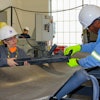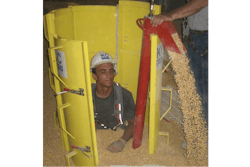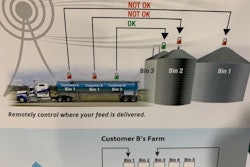Transcription of Feed & Grain Chat withKristen Ireland, co-founder, PeopleSpark Consulting.
Elise Schafer, editor of Feed & Grain:Welcome toFeed & Grain Chat. I'm your host Elise Schafer, editor ofFeed & Grainmagazine.
This edition ofFeed & Grain Chatis brought to you by WATT Global media and Feedandgrain.com. Feedandgrain.com is your source for the latest news, product and equipment information for the grain handling and feed manufacturing industries.
Today I'm joined on Zoom by Kristin Ireland, co-founder of People Spark Consulting, a human resources consulting company that helps small to midsize ag businesses achieve their goals.
Kristin has more than 20 years of experience coaching executives, leaders and managers in HR and leadership development. Thanks for joining me today, Kristen.
Kristen Ireland, co-founder, PeopleSpark Consulting: Thank you. I'm looking forward to this.
Schafer:Yes, I am, too. Let's get right into it and talk about employee engagement. Why is it important for feed and grain facility managers to keep their employees engaged at work?
Ireland:That is a great question. And a great topic with everything that's going on right now in our labor industry and in the industry as a whole, right. And first of all, before we talk about engagement, I thought it would be important to talk about engagement and what it is and what it isn't. So historically, at least when I started in human resources, there was a lot of focus on employee satisfaction. And so businesses were [saying] we're doing employee satisfaction surveys and talking about satisfaction.
And as we've started to move into engagement, it feels like in some cases people are using those terms similarly, that engagement is the new word for satisfaction when actually there's some very distinct differences between the two.
Employee satisfaction looks more at what if an employee is satisfied with what they get. Are they satisfied with their salary? Are they satisfied with their benefits? Are they satisfied with their work?
Employee engagement is more about what do they bring. What are they giving? Are they bringing, you know, are they excited to come to work? Are they choosing to bring more of their focus and energy? Because engaged employees are the ones — they’re your rock star employees — who are going to be bringing 110%. They'll take initiative, they'll do the work without you asking, they are bringing it. So we want engaged, not — satisfied is good, too. We want to focus specifically on engaged.
There has been so much research on the importance of having engaged employees. So if you compare businesses with highly engaged employees and businesses that aren't, the businesses that have highly engaged employees experience, for example, 41% lower absenteeism.
When I think about that statistic right now, I think about how many of our clients and how busy how many businesses we hear from who, here they're being ghosted, people aren't showing up on the first day of work, they're calling in sick, they're showing up late, right? That if through engagement, we can decrease that absenteeism by 41%, that's a win for everybody.
That's only one statistic. There's higher productivity — 17% higher productivity. If you look at that in a 40-hour work week that's like an additional day a week that you're getting from all of the work that your employees are doing. Twenty-one percent higher profitability, who doesn't want 21% higher profitability?
One of the last ones that really stood out to me, too, is turnover. Depending on your industry, you can experience up to a 59% lower turnover rate with engaged employees because engaged employees are the ones that are coming. They're not spending their time looking for other jobs. They're the ones who are making statements like my spouse has never seen me so happy at work. We had a client who shared that example with us, right. So they're leaving less.
参与员工不运动的人for $2 more an hour down the street, so your turnover can decrease as well the more engaged your employees are. Huge impact!
Schafer:Absolutely. Safety is critical in this industry. Can you talk about the correlation between employee engagement and safety incidents?
Ireland:That is a great question. Safety is something that is near and dear to my heart as well. That same study showed that highly engaged teams have 70% lower safety incidents, right. And as we think about, especially when I think about, the agriculture industry, so much of this is relationships that we are connected with our employees and our communities, that have having engaged employees can keep them safe — even better. So there is a huge correlation between engagement and safety.
Schafer:So since safety is so important and so is engagement, what are some ways that managers can boost engagement at feed and grain facilities?
Ireland: I love this question because there's so much. As an HR person, I'm constantly reading articles around engagement. They're always like the five tips to increase engagement and it feels overwhelming. There are so many different things. And every article has like five different things so that it's hard to know where to focus.
One of our favorite books is theNine Lies About Work. They do a lot of great studies, and they did a study on engagement surveys in organizations.
They found that there are eight things that are disproportionately present in highly engaged teams. And the eight things are things like, I am enthusiastic about the mission of my company, I have confidence in my company's future, my teammates have my back, I clearly understand what's expected of me, I know I will be recognized for excellent work, I get to use my strengths every day, so those are a few of the eight.
You'll notice the theme there. What usually stands out when we share those eight, is people are surprised that pay isn't mentioned. Because that's the first thing we default to — somebody else is paying more. I can't pay that much. How am I going to increase my pay? And, sure, pay can be a factor, but there are so many other things that you can do to impact engagement that aren't related to pay.
Schafer:How can companies measure employee engagement in order to gauge whether their efforts are paying off or not?
Ireland: This is a question we hear a lot. We have some leaders and some businesses who really want to embrace this concept around engagement. And they'll put together an informal or internal engagement survey and try to measure what those actual engagement levels are. That is one way. Having an engagement survey is a way to be able to do that.
How you go through the process of completing an engagement survey directly impacts engagement, right? So if you're not following up on the engagement survey, if you're forcing people to complete the survey or complete in a way where they feel pressured, and they feel like they don't have another choice, that's going to impact your results — they're going to be skewed.
It can decrease engagement because of the feeling that gives. So yes, that is an option. If that is an option that somebody wants to pursue, we want to make sure that that we're being thoughtful and intentional about how we're doing it, that we're not just sending out a survey, getting the data and moving on, because that will decrease engagement.
What I encourage managers and business leaders to do is to look around, because there will be symptoms that you see that tell you that you have a disengaged workforce. And my guess is you're feeling it already.
So, are people leaving? Is there high turnover? Are people — I heard this the other day — hiding? They'll talk about what people know where to hide, they know where to get away. Are they spending a lot of time on their cell phones, not doing work? I realize some work relates to using your cell phone, but are they using their cell phone not related to work? Are they not showing up? Do you have to tell them every step that they need to take? Those are symptoms of disengagement.
The overall symptom, too, is are you not meeting your goals? Because if engaged employees are more productive and more profitable, I would expect that if you have a highly engaged workforce, that you're seeing that in the bottom-line results that you have. While you can officially measure that, and that is an option, sometimes your gut feel is the best one.
Schafer:现在,如何从监督m直接反馈anager impact an employee's level of engagement?
Ireland: We talked about the eight factors of engagement. We were actually at a speaking engagement a few months ago, and somebody raised their hand and said, 'If I could do one thing,one thingto impact engagement, what would it be?'
My response was coach and provide feedback. First of all, I listed six of the eight factors of engagement. All eight factors of engagement can be impacted or influenced by having good effective coaching conversations with employees. And the best part is that doesn't even cost you any money.
As we think about salaries, we're talking about increasing budgets, having good conversations, good, effective feedback, conversations with your employees doesn't cost you anything, and it can impact all eight. So having a good effective conversation with your employees so that the same book that I talked about, theNine Lies About Work, they also talk about the impact of attention or feedback on employees.
我们往往听到的,我认为我提到的这个earlier, is leaders and managers are hesitant to give feedback to employees because if I give them constructive feedback, they’ll leave. We hear that a lot. And nobody is better — orsomebody is better than nobody was the other way we hear that.
他们还建立在这项研究中,发现甲板g negative feedback or negative attention is 40 times more effective as a leadership technique than ignoring people.
When I give that statistic, usually people say, 'Well, I'm not ignoring people, right?' But when you think of those situations where you could provide coaching or constructive feedback to an employee, what could be perceived as negative, and we choose to walk by it because we don't want to make them mad. We don't know what to say, because we're frustrated and we just need a break, whatever that reason is — if we choose to walk by it, our intent may not be ignoring, but that's the impact that it has. So it's 40 times more effective to give that feedback than to not.
The same study indicated that positive feedback — positive attention — is 30 times more effective than negative feedback — negative attention — in driving that engagement, which isn't surprising.
We all know that recognition is going to have more of an impact than constructive feedback. What we tend to miss as leaders is the opportunity to recognize people, because that's not what stands out to us.
What stands out to us is the person who's not doing their job, the person who is a pain point, the person who may need that constructive feedback. And we don't notice, and that's not a judgment call, it's day to day — it's not what comes to our minds, it's not necessarily what we see when somebody is doing their job and doing it well.
So as we miss those opportunities — again, not ill-intended, we're all busy. As we miss those opportunities, we are not engaging our employees, right? The impact is ignored and that's not our intent. The more we see those things, the more we can recognize, the better it is. So having that feedback again — and I would say this again — one thing that you could do to increase engagement of your employees is give effective feedback. The study shows why that's important. But that's the number one thing.
Schafer:Now, giving feedback can be hard and a challenge for managers for many of the reasons that you mentioned. Do you have any tips or advice on how to provide effective feedback?
Ireland: Yes, we see a lot of hesitation for a number of reasons for people giving feedback.
First of all, one of the things that we have found in working with the agriculture industry is we have a lot of leaders who have been promoted from individual contributor roles because they're really good at their individual contributor roles.
They are rock stars, they are engaged employees, we want to keep them. We promote them, which is great, and in many cases, they may not have either the experience or the training in what does that mean to be an effective leader. How do you lead a team to complete the work, not just complete the work yourself?
We do see that as a development need within the ag industry around these new leaders who don't know how to give effective feedback, and that a lot of times were uncomfortable with it. We found this very early on when we started People Spark Consulting. Again, when people think about human resources, they think about processes. The skillset to deliver effective feedback is as important, if not more important, than this process is to support it.
There are ways that you can, and there are more than I can give in the next few minutes, but there are ways that you can lean into these conversations that you can give effective feedback in these conversations, both from a constructive perspective and an intent to improve performance.
We actually had somebody who went through one of our leadership development programs, who at the beginning said, ‘My employees hide from me.’
He had the hiders, where they knew where to go hide, and he started to give them feedback. He was so shocked by the response because what they did was ask for more!
It wasn't, they don't hide from me anymore — which was kind of the best statement — but he said then they asked, ‘Can we have more conversations like this?’
They wanted more and he wasn't always giving recognition, he was giving constructive feedback. They wanted more of it. There are ways that you can approach that so you are increasing engagement and have the impact that you want to have.
Schafer:Kristen, this has been a lot of great information, and I'm sure it's just the tip of the iceberg. Thank you again for coming toFeed & Grain Chattoday and sharing your insights.
Ireland: Thank you for inviting me. This was fun.
Schafer:If you'd like more information about what you learned today, visitpeoplesparkconsulting.com. That's all for this edition ofFeed & Grain Chat. Thank you, everyone, for watching, and we'll see you next time.
Grain and feed facility managers have many responsibilities, ranging from ensuring employeesafetyto meeting profitability and productivity targets totrainingemployees. But many don’t know they can impact all those aspects of management throughemployee engagement.
In thisFeed & Grain Chat,Kristen Ireland, co-founder ofPeopleSpark Consulting, discusses how employee engagement can help reduce turnover, develop goodleadersand the value of providingfeedbackto your employees.






















